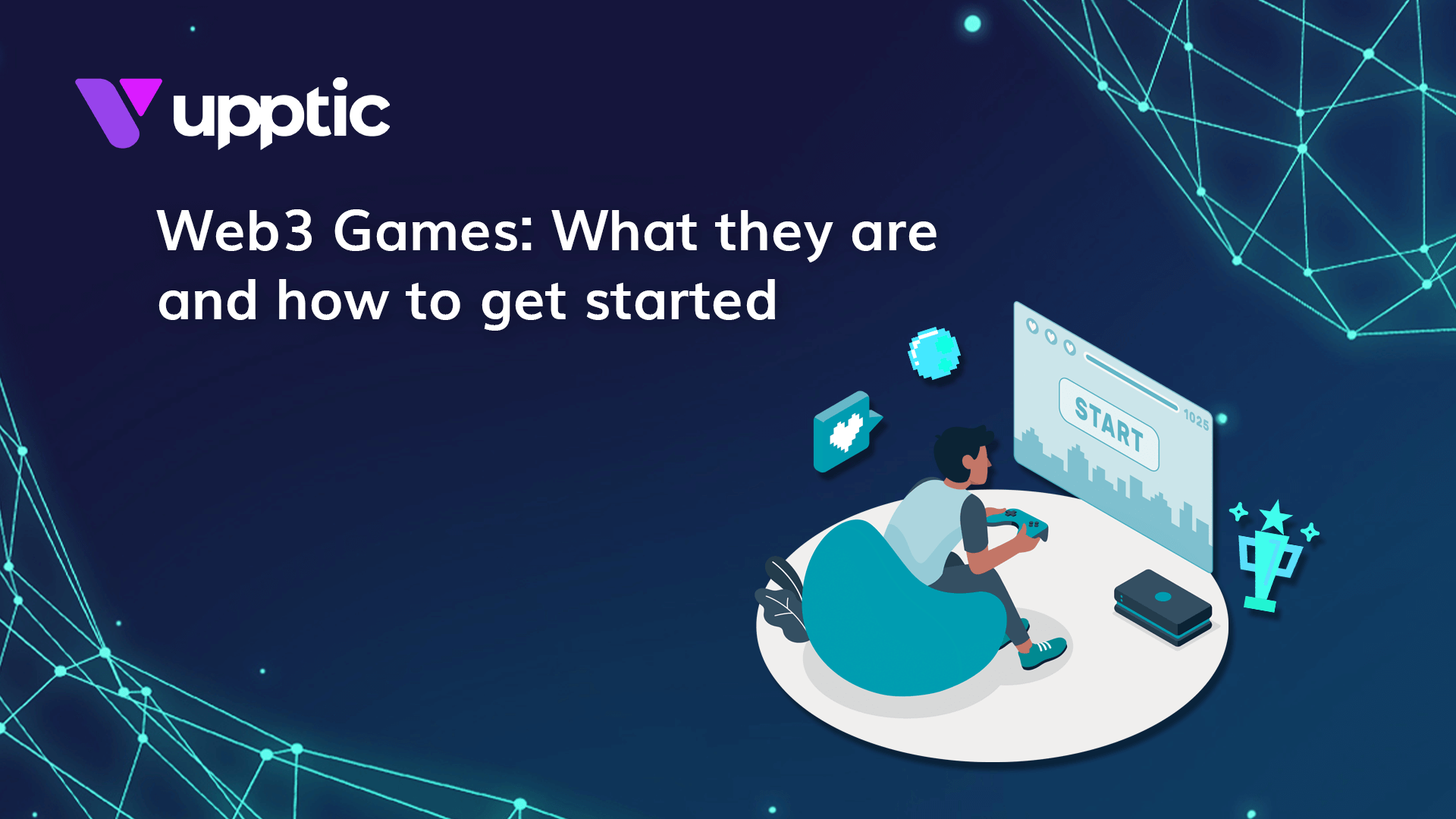The enigmatic rise of web3 games is one of the most meteoric rises and subsequent corrections of modern gaming history. The aggressive investment into web3 games publishing – an incredible $4.4 billion in 2022 – has triggered a divisive response and significant upheaval amongst gamers, publishers, and developers alike.
A new generation of game companies and service providers quickly blossomed into existence and are scrambling to enable (and get a piece of) this new gaming gold rush. However, reception from gamers and the mainstream gaming press has been skeptical. Many gamers are repelled by the negative association with NFTs, while others are skeptical of change in an industry which has managed to consistently increase pricing over time.
Regardless of the skepticism, many developers and publishers continue to invest heavily into web3 gaming infrastructure. If you’re interested in learning about this dynamic space, this definitive guide will detail what web3 gaming is, what’s trending, and how to build and launch a web3 game in order to capitalize on all the possibilities.
Use this chapter selector to jump to a specific section:
- What is web3 gaming?
- What’s under the hood of a web3 game?
- Who are the players in the web3 gaming ecosystem?
- Web3 games publishing
- Challenges in web3 gaming
- Solutions to web3 gaming issues
What is web3 gaming?
Web3 gaming refers to a new generation of online games that use blockchain technology and decentralized systems to provide a more secure and transparent gaming experience. These games typically use cryptocurrencies and other blockchain-based tokens to facilitate transactions within the game, giving players full ownership and control over their virtual assets.
The goal of web3 gaming is to provide a more immersive, equitable, and community-driven gaming experience by eliminating the need for centralized intermediaries and giving players more power and autonomy in their virtual worlds.
What are web3 games?
Web3 games allow players to own in-game assets and store them in custodial wallets as fungible tokens or non-fungible tokens (NFTs). This innovative web3 technology provides players with the benefit of tangibly-owned assets which can be traded in open marketplaces and even potentially transferred from one web3 game to another.
This newly developed technology and subsequent social movement is one of the major underpinnings of web3 games – leading to new gaming models such as Play-to-Earn and Play-and-Own. Web3 infrastructure includes promising changes that will emphasize the interest and involvement of individual users and pave the way forward for digital gaming.
How do web3 games compare and contrast to the web 2.0 era of gaming?
The web 2.0 era provided many innovations that formed the infrastructural backbone and foundational design schema for today’s digital games. This includes in-app purchases, microtransactions, and the fundamental centralized services that run the games. Additionally, social media and underlying web and marketing services – such as Facebook and Google – were the quintessential distribution methods of the web2 era.
However, web2 companies and infrastructure are inherently centralized and definitionally opaque. This has led to a consolidation of data and the monopolization of segments of the game industries.
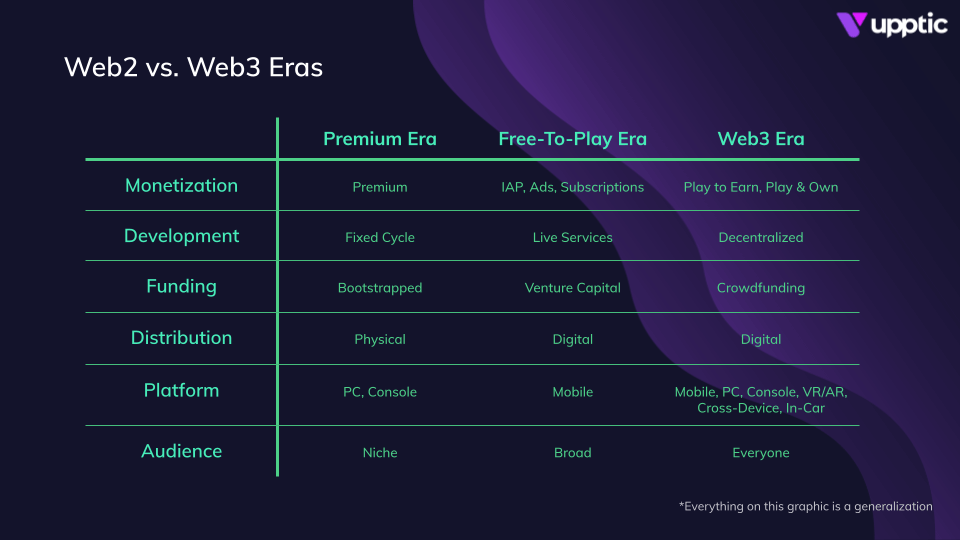
Premium and Freemium games
In the web2 era, there were two main traditional monetization methods in gaming: premium and freemium. With premium games, players make a one-time purchase to gain full access to the entire game. This is still the standard type of monetization for PC and console gaming.
Freemium games, also known as free-to-play (F2P) games, on the other hand, were typically free to download but were monetized through in-app purchases or in-game ads. Once these became available on mobile devices, they quickly supplanted premium games in revenue generation.
In fact, this monetization model has become so successful that it now generates 78% of gaming revenue – even accounting for premium sales on consoles and PC. Core F2P features, such as microtransactions, have also bled into premium games – much to the disdain of many gamers.
What can you do in web3?
Web3 infrastructure, while still evolving, provides its users with transparency and the opportunity to govern game development. It allows gamers actual ownership of digital assets and the ability to transfer digital assets between each other within digital marketplaces.
Web3 platforms that grant some level of game ownership to their communities will likely succeed over those that don’t. Giving players a tangible stake in a game and its assets encourages loyalty and growth in the web3 era.
Play-to-Earn and Play-and-Own games
One of the major changes in the way web3 digital games are run involves Play-to-Earn (P2E) games. P2E games provide gamers with rewards that hold real-world value. These come in the form of in-game NFT assets, allowing gamers to trade or sell them for actual money in the marketplace. This means the player has an ownership stake in the game itself.
On the other hand, while Play-and-own (P&O) games do harbor elements of P2E mechanics, they place more emphasis on community, fun, and long-term economic sustainability. P&O games allow their players to use their in-game assets in ways that help to create an emotional connection to the game. These include character development, narratives, and community interaction.
Interoperability
One of the most intriguing aspects of web3 gaming is its potential to provide interoperability across various games. For instance, players could potentially take digital assets procured from one game and transfer it to other games in a way that is functional. While this will ultimately require game developers to work together to make this reality, the underlying infrastructure to make it happen already exists with web3 technology.
The metaverse
A metaverse is a digital “reality” complete with marketplaces, communities, and real-world rewards. Because these are often the core features of many web3 games, they are often considered the closest things to a fully-realized metaverse that currently exist.
What’s under the hood of a web3 game?
At its core, web3 games run on blockchains – which allow for more open and transparent systems that are decentralized. But web3 technology includes many components, from smart contracts to digital wallets. Here is a look at the core components of web3 technology.
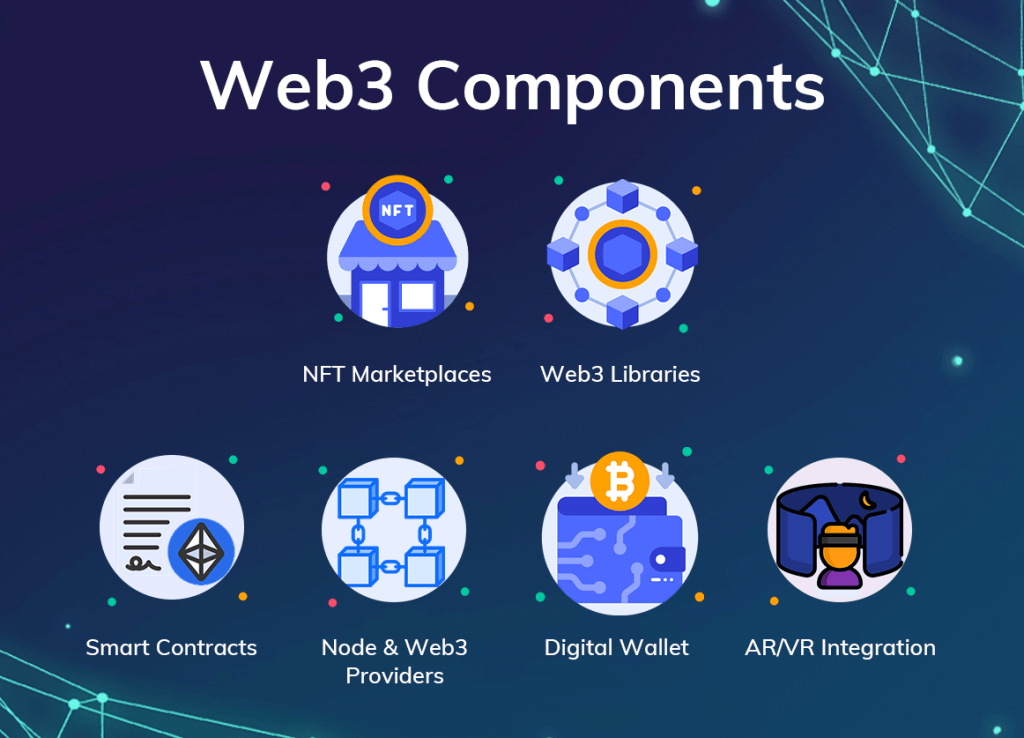
NFT marketplaces
NFTs, or non-fungible tokens, are digital assets built on blockchain technology that represent ownership of a unique item or collectible that cannot be replicated or replaced. NFT marketplaces were designed for the trading of NFTs – whether for monetary gain or for swapping digital assets.
NFT marketplaces ultimately allow players to own and trade unique in-game items. This creates new opportunities for game developers to monetize their content and for players to have a sense of ownership and investment in the game.
Web3 libraries and dapps
Web3 libraries are software libraries that provide developers with a set of tools and APIs to interact with blockchain networks and build decentralized applications. These libraries are built on blockchain protocols and provide a high-level interface for developers to interact with smart contracts, conduct in-game transactions, and retrieve data from the blockchain.
Web3 gaming decentralized applications, or dapps, run on a blockchain. They are built on web3 libraries, and smart contracts are used to execute certain business logic and store data on the blockchain.
Smart contracts
Smart contracts in web3 gaming are self-executing contracts used to automate the voting and decision-making in game evolution as per player requirements. For example, many game developers use the Remix IDE to deploy, compile, and write smart contracts. However, if you require a local development ecosystem, tools like Brownie, Truffle, and Hardhat are easy to use.
Node and web3 providers
Nodes or web3 providers are responsible for extracting gaming information stored on the blockchain network. They also maintain and verify the network’s security, integrity, and decentralization. It acts as a bridge between dapps and the blockchain network, allowing developers to send transactions, read data from the blockchain, and interact with smart contracts without managing the underlying infrastructure.
Digital wallets
Digital wallets are software programs or apps that store and manage private keys, public keys, and other information necessary to interact with blockchain networks and manage digital assets such as cryptocurrencies and NFTs. They allow users to securely store, send and receive digital assets, and interact with smart contracts and dapps.
AR and VR hardware
AR (Augmented Reality), VR (Virtual Reality), and haptics technologies provide novel gameplay experiences for gamers. AR technology is used in games to display in-game items in the real world or provide location-based gameplay. VR technology allows players to explore virtual worlds and interact with digital objects in a seemingly realistic way. Lastly, haptic technology provides players touch and physical interaction in virtual environments.
All these technologies can be integrated with web3 digital games, allowing for a more immersive and engaging gaming experience where players can own and trade unique in-game items and interact with other players in shared virtual worlds. These technologies also have the potential to create new business models and revenue streams for game developers and creators.
Interoperability standards
Interoperability refers to the ability of different games and platforms to allow players to share assets and in-game items seamlessly. In web3 gaming, interoperability is realized through blockchain technology and common protocols and standards. For example, it allows for the creation of fungible and non-fungible tokens on the blockchain, which can be used across multiple games and platforms.
Standards for interoperability are also evolving as the web3 game industry develops, and new protocols and standards are being proposed and adopted by the community.
Who are the players in the web3 gaming ecosystem?
Decentralized Autonomous Organizations (DAOs)
Decentralized Autonomous Organizations (DAOs) are built on blockchain technology and focus on providing a decentralized and community-driven gaming experience. Gaming DAOs are typically governed by smart contracts to create and manage in-game assets, player accounts, and game logic.
DAOs can be categorized into the following three fundamental types.
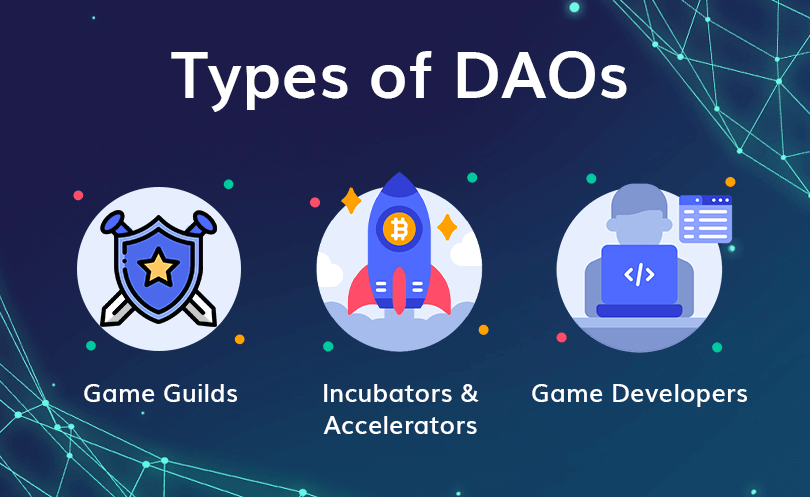
Gaming guilds
Gaming guilds are decentralized communities of players that come together in online games, organized around a common interest or goal and are governed by smart contracts. Guild members can hold and trade in-game assets through unique NFTs and split revenue among players.
Popular DAO gaming guilds include Yield Guild Games, Merit Circle, UniX Gaming, Avocado DAO, and Good Games Guild.
Incubators and accelerators
Incubators and accelerators are another type of gaming DAO that focuses on the growth of web3 gaming platforms by providing expert knowledge to platform founders. They promise game developers funding for new ventures and provide technical solutions and advanced tools to update and develop their web games.
Popular incubators and accelerators focused on web3 gaming include The Sandbox Metaverse Accelerator Program and The Cronos Accelerator Program. These incubators and accelerators provide resources, mentorship, and funding to help web3 startups grow and support game developers creating blockchain games.
Game developers
Many web3 game developers also operate DAOs. These DAOs are focused on creating and developing games on the blockchain and are governed by a set of rules and protocols encoded in smart contracts. The game development process is community-driven, and decisions are made through voting. Meanwhile, development funds are raised through token sales or crowdfunding.
A few examples of popular DAO game developers include Decentral Games, BuidlGuidl, Yield Guild Games, Star Atlas DAO, Merit Circle, MintWorld, Galaxia Studios, and CroSkull NFT.
Traditional Game Companies
Publishers
Many traditional game publishers are transitioning into web3 to explore new opportunities and revenue streams in the gaming industry. Ubisoft, one of the largest game publishers in the world, announced in 2020 that they were investigating the use of blockchain technology to create new gaming experiences and business models.
Atari, one of the most iconic game publishers, also announced plans to use blockchain technology to create new gaming experiences and revenue streams. They are particularly interested in allowing players to own and trade in-game assets.
Animoca Brands is a mobile game publisher that has also been experimenting with web3 technology. They have already published several blockchain-based games, such as Benji Bananas, F1 Delta Time, CryptoKitties, and The Sandbox.
Developers
Various traditional game developers are now trying out web3. These include popular game companies like Epic Games, Nintendo, Ubisoft, Tencent, and Take-Two Interactive. Epic Games has moved into web3 gaming with their game, “Blankos Block Party”. Take-Two has acquired Zynga, a mobile game publisher currently trying out NFT-based games. Additionally, Ubisoft released in-game NFTs for the game; “Ghost Recon Breakpoint”.
Marketing Companies
Web3 has also caught the attention of traditional marketing companies ready to explore new opportunities in the blockchain and crypto spaces. Upptic is leading the charge on building marketing strategies, tools, and best practices for web3 games. Other marketing companies who are also looking into the web3 space include Mindshare, Publicis Sapient, WPP, Ogilvy, and Accenture Interactive.
Web3 games publishing
Web3 game developers tend to build and market their games by nurturing and engaging with communities throughout game development and live operation.
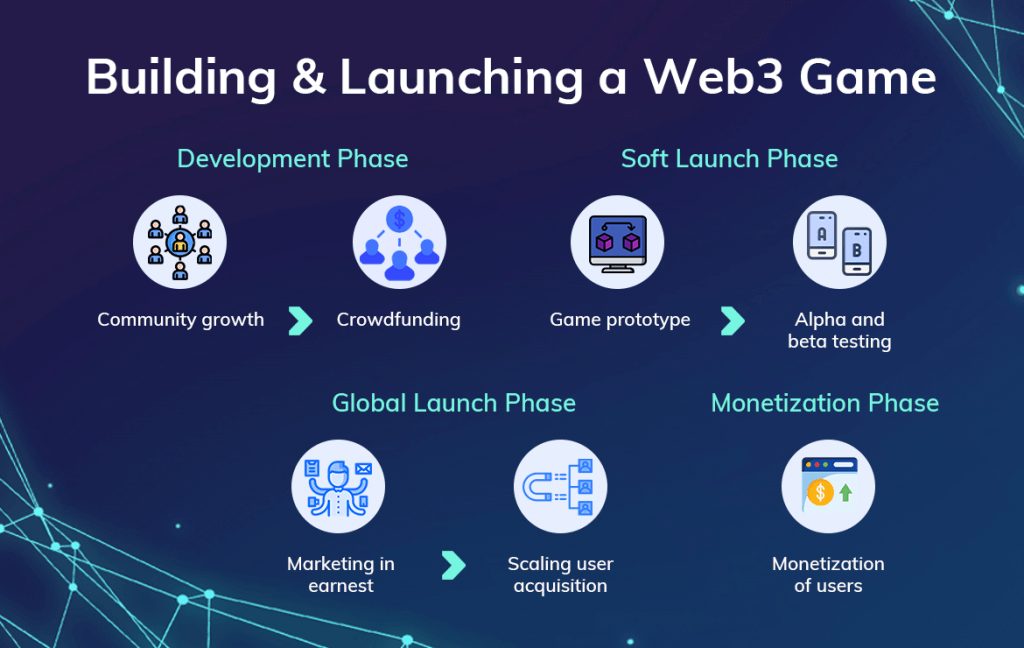
Development phase
Online communities play a vital role in the funding, development, and success of web3 games. Web3 game developers often use crowdfunding and token sales to fund game development and build a community of early adopters.
Developers can also use community-driven events to encourage players to contribute to game development. These events create a sense of collaboration and shared ownership in the community.
One way to create an organic community is by gathering feedback and answering questions about the game through social media – though many developers also build servers on Discord dedicated to their games, where they can engage directly with their player-owners.
Soft launch phase
During the soft launch phase, developers provide a prototype version of the game for players to test-play and gather data on performance, pain points, and player experiences. This phase is also known as the alpha or beta testing phase, and it’s a crucial step in the game development process as it allows the developers to gather valuable feedback and make improvements before the game’s official launch.
Global launch phase
In this phase, marketing starts in earnest and growth begins to scale. Marketing for web3 games has proven to be drastically different from marketing for web2 games on mobile, PC, or console.
Web 3 gamers tend to have a great distaste for traditional digital advertising. And the decentralized and fragmented nature of web3 makes data aggregation and analysis extremely difficult as well. Because of this, marketing in web3 is much more organic and often involves building or connecting with online web3 gaming communities.
While web3 games have fostered dedicated player bases, so far none have really broken into the mainstream.
Monetization phase
In the monetization phase, developers begin to focus on monetizing players. Thus far in web3, users have largely been monetized through NFT sales.
These sales can incentivize players to stick with a game long-term as they provide a stake of ownership in the game. Additionally, thanks to the nature of smart contracts, game developers can set trading fees on any of their NFTs and take a cut of the revenue anytime a player resells the NFT in any marketplace.
While this holds some promise, NFT sales as a monetization model also has some limitations that need to be thought out, as you’ll learn below.
Challenges in web3 gaming
While web3 gaming offers game developers and players with many new opportunities, it’s not without its challenges. There are clear issues with monetization and user acquisition. Additionally, there is a large amount of stigma that must be overcome.
Here’s a more in-depth look at these critical challenges.
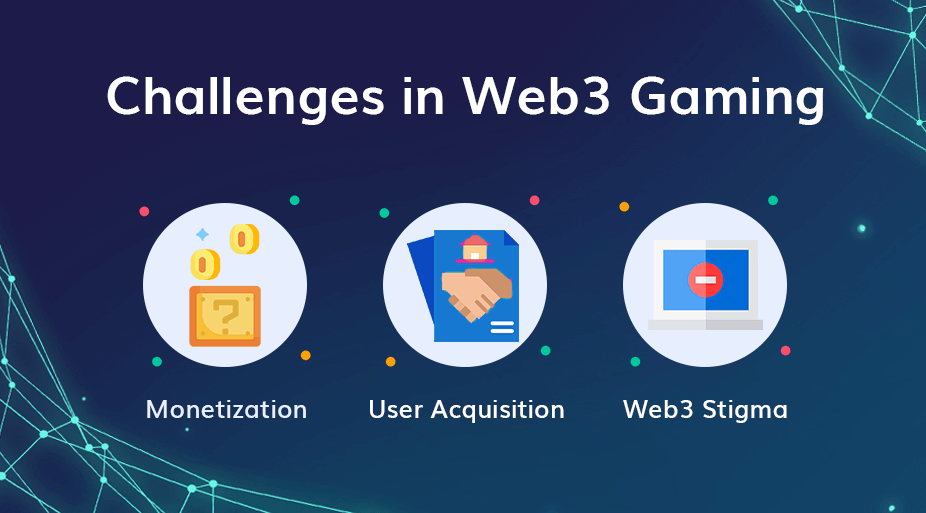
Monetization
As mentioned above, the main way to monetize users in web3 games is through NFT sales. While game developers can theoretically create a long-term sustainable revenue stream off of NFT resales, that only holds true if it is coupled with long-term player retention.
Without long-term retention, one of the biggest points of concern revolving around NFT sales as a monetization model is sustainability. It’s even been likened to a Ponzi scheme – especially in games with a Play-to-Earn model. In order to keep paying current gamers, new gamers are required to essentially invest in the game.
Additionally, token sales can be highly speculative and volatile, making it difficult for developers and player-owners alike to predict and plan long-term.
The Play-to-Earn model also has its own set of issues, as some gamers may be able to earn more than others, leading to player imbalance and dissatisfaction.
Ultimately, the web3 games space has yet to showcase a proven long-term effective monetization model. However, the industry is still in its early stages, with limited data on what really works for web3 digital games.
As the space evolves technologically and socially, new monetization models will continue to be tested until some prove to be effective and sustainable.
User acquisition
User acquisition is a crucial aspect of the game publishing process, but acquiring new users for web3 games can be tricky.
Firstly, web3 gamers are often wary of traditional advertising methods. This is one of the reasons online communities take on greater importance in web3 gaming user acquisition. Additionally, due to its decentralized nature, the space is extremely fragmented – making data collection, attribution, tracking, and other important parts of traditional user acquisition a serious challenge.
Onboarding players, especially non-web3 players, can be more demanding as well – since web3 games often require players to have a digital wallet and a basic understanding of blockchain and crypto.
Lastly, scaling user acquisition can be a challenge in web3 gaming, as the market is still relatively new and there needs to be more data and analysis on user behavior to craft effective acquisition strategies.
Web3 stigma
As if the challenges with monetization and user acquisition weren’t enough, there is also a social stigma attached to web3 games, blockchain, and crypto – which recent volatility in the crypto industry and subsequent collapse of several companies has only made worse.
Currently, many gamers also see NFTs as a new form of microtransaction – a feature from the web2 era that many gamers still take issue with due to a belief that its only purpose is to milk them for all they’re worth.
As mentioned before, there is also a stigma among not only gamers, but developers, that web3 and crypto are essentially Ponzi schemes – which, given recent revelations about companies like FTX, people can hardly be blamed for believing.
Solutions to web3 gaming issues
Fortunately, while the above issues may be complex, there are many ways developers can address these challenges.
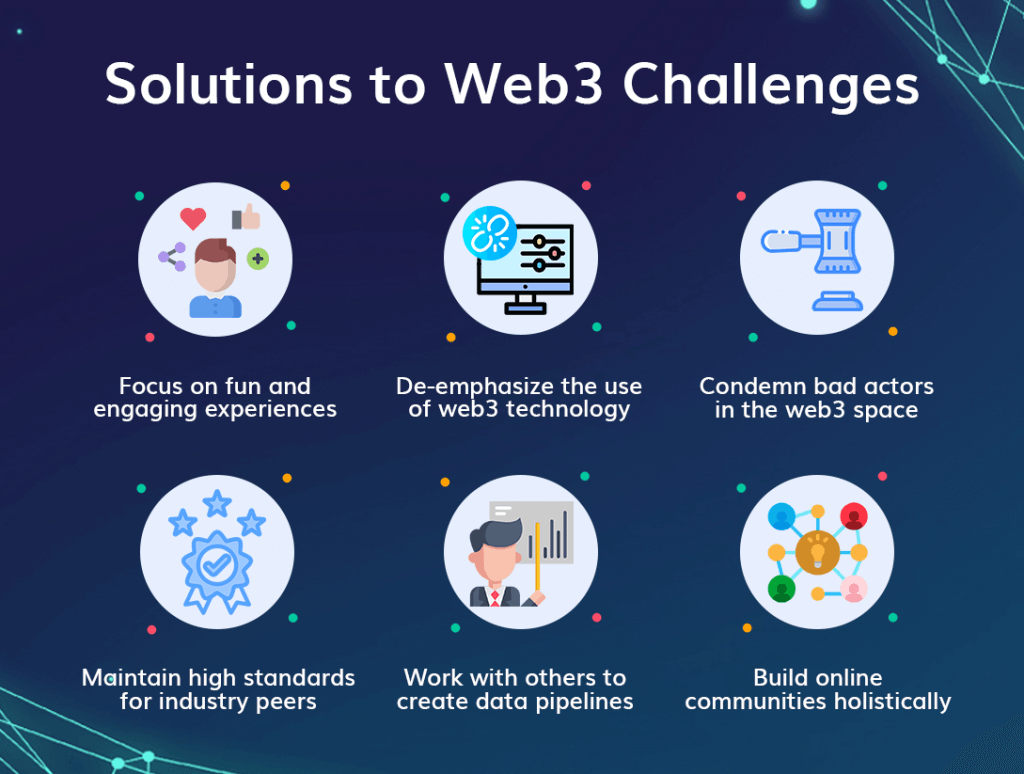
Additionally, games should encourage the collection and trading of NFTs through narratives and engaging mechanics – rather than hype the chance to make money. This will lead to longer-term gameplay and retention which can make the resale of NFTs more sustainable.
Developers and others in the space should also remain vigilant and condemn bad actors, such as those who engage in any illegal or unethical activities. Standards for partners and competitors alike need to be sky-high in order to foster trust in an industry that has already seen its fair share of deceit and abuse.
Developers should also work together, and with other entities, to create standards and pipelines that make it easier for players to get onboarded in games as well as ensure data is properly tracked and attributed across the web3 ecosystem.
Lastly, developers should build online communities holistically, with the focus being to connect with players and supporters over a shared love of games, rather than to sell NFTs or crowdfund their latest pet project.
Axie Infinity
Developer: Sky Mavis
Chain: Ronin
In Axie Infinity, build up a collection of fierce creatures, called Axies, to battle, build, and hunt for treasure.
Project Eluüne: StarGarden
Developer: Arrivant
Chain: Solana
Build creature armies and outsmart enemy forces in this free-to-play team-based auto-chess battler.
BattleFly
Developer: BattleFly
Chain: Arbitrum
Equip your BattleFly with mods and fight enemies in a P2E/PVP environment in this blockchain game.
The Harvest
Developer: Falco
Chain: BNB
The Harvest is a third-person shooter where you collect NFT cards, team up with friends, and fight other teams.
The Sandbox
Developer: PixOwl (published by Animoca Brands)
Chain: Ethereum
The Sandbox is a community-driven platform where people can build and monetize game assets and experiences.

